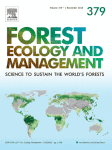Ver ítem
- xmlui.general.dspace_homeCentros Regionales y EEAsCentro Regional Patagonia SurEEA Santa CruzArtículos científicosxmlui.ArtifactBrowser.ItemViewer.trail
- Inicio
- Centros Regionales y EEAs
- Centro Regional Patagonia Sur
- EEA Santa Cruz
- Artículos científicos
- Ver ítem
Environmental variables influencing regeneration of Nothofagus pumilio in a system with combined aggregated and dispersed retention
Resumen
The current silvicultural prescriptions for Nothofagus are designed to stimulate natural regeneration by opening the canopy. One of these methods is variable retention, which can include either or both aggregated and dispersed retention. Different degrees of retention may modify microclimatic variables differently and consequently offer dissimilar microenvironmental conditions for regeneration. Retained canopy influences both biotic and abiotic factors.
[ver mas...]
The current silvicultural prescriptions for Nothofagus are designed to stimulate natural regeneration by opening the canopy. One of these methods is variable retention, which can include either or both aggregated and dispersed retention. Different degrees of retention may modify microclimatic variables differently and consequently offer dissimilar microenvironmental conditions for regeneration. Retained canopy influences both biotic and abiotic factors. The objective was to evaluate Nothofagus pumilio regeneration along edge-related gradients within aggregated retention, and in the differentmicroenvironments within the harvested areas. The remnant canopy cover after harvesting greatly influenced regeneration mainly by decreasing radiation transmittance and soil moisture availability. Aspect (direction to the azimuth) and distance from edge of aggregates influenced regeneration density, height and growth. In dispersed retention, microenvironments generated by different types of understory plant cover, debris,
and proximity of remnant trees also influenced regeneration. High levels of understory cover (up 50%) and medium levels of harvesting debris cover (25–50%) had a positive impact, while close proximity to remnant trees had a negative impact on regeneration. These findings can be used to improve silvicultural and harvesting prescriptions to ensure successful establishment of regeneration and maximize potential growth.
[Cerrar]

Autor
Martínez Pastur, Guillermo José;
Cellini, Juan Manuel;
Lencinas, María Vanessa;
Barrera, Marcelo Daniel;
Peri, Pablo Luis;
Fuente
Forest Ecology and Management 261: 178-186 (January 2011)
Fecha
2011-01-01
Editorial
Elsevier
Formato
pdf
Tipo de documento
artículo
Palabras Claves
Derechos de acceso
Restringido
 Excepto donde se diga explicitamente, este item se publica bajo la siguiente descripción: Creative Commons Attribution-NonCommercial-ShareAlike 2.5 Unported (CC BY-NC-SA 2.5)
Excepto donde se diga explicitamente, este item se publica bajo la siguiente descripción: Creative Commons Attribution-NonCommercial-ShareAlike 2.5 Unported (CC BY-NC-SA 2.5)

